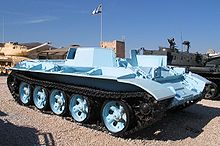South Lebanese Army
The South Lebanese Army (SLA; French Armée du Sud Liban , Arabic جيش لبنان الجنوبي, DMG dschaisch lubnân al-dschanûbî , Hebrew צבא דרום לבנון, צד"ל Tzava Drom-Lebanon TzaDaL) was a Lebanese militia during the Lebanese civil war . She collaborated with Israel in its occupation of southern Lebanon .
history

The SLA was initially created as the "Free Lebanon Army" (FLA) during the Lebanese civil war in 1976 by splitting off part of the Lebanese army commanded by Major Saad Haddad in the cities of Marjayoun and Qulayaa . Its founders were, besides individual Shiites and Druze , predominantly Christians . Their struggle was directed against the Shiite Amal militia and the PLO , which at the time ruled southern Lebanon. The ostensible aim was to protect Lebanese civilians. As a mutual opponent of the Amal militia and the PLO, the SLA and Israel formed an alliance since 1978.
The SLA leader was Major Saad Haddad until his death from cancer in 1984 and later the retired Lieutenant General Antoine Lahad .
Until Israel invaded the Lebanon War in 1982 , the SLA fought the PLO in the south of the country. After the establishment of the so-called 'security zone ', which was de facto an occupation , the SLA's operations were directed against the resistance of Hezbollah, which was mainly supported by Iran, and Amal, which was supported by Syria . In 1985 the Israeli Army (IDF) withdrew partially and left control to the SLA, which in the same year established its main prison in Chiyam and introduced a year-long general conscription in southern Lebanon. The SLA was continuously supported logistically by Israel with money, weapons and associated ammunition.
Despite the temporary presence of 1,000 to 1,200 Israeli soldiers in southern Lebanon, the SLA bore the brunt of the fight, including the administrative management of the occupied area. The SLA area was not completely identical to the Israeli-occupied buffer zone in southern Lebanon, but went considerably further with the Jezzine section to the north of it . Israeli and SLA interests were therefore not completely congruent. The SLA has been charged with the murder of many civilians in order to intimidate the population and the occasional bomb attacks outside the security zone.
In the 1990s, Hezbollah increasingly attacked the militia, most recently with the support of the Lebanese army's secret service , which had infiltrated the SLA. As a result of desertion and a lack of support in the occupied area , the militia accused of collaboration with the Israelis continued to decline (1980: 5,000, 1990: 3,000, 2000: 1,500).
Disintegration of the SLA
In May 2000 the Israeli army left the occupied zone regardless of the SLA. After the withdrawal became known, Lebanese civilians overran the militia bases and forced them to give up. Many refugees returned to their villages from Lebanon and Hezbollah took control of the area, sometimes fighting.
Some of the members of the SLA fled to Israel with their families. Others surrendered or were handed over to the police by Hezbollah or, depending on their share in the resistance, released. Many were granted asylum in Europe, especially in Germany . Lebanon itself viewed them as 'collaborators with the enemy' and imposed prison terms; some were sentenced to forced labor for assaulting civilians .
The Israeli Prime Minister Ehud Barak was criticized in Israel for the sudden withdrawal of the Israeli army and the subsequent collapse of the security zone.
After Hezbollah security guarantees, many families returned to Lebanon, and a third of the 6,000 or so refugees accepted Israel's offer to obtain citizenship; this included financial support similar to that for new immigrants, as well as the right of residence, but also conscription. On 6 April 2006, the Finance Committee approved the Knesset also the payment of 40,000 NIS (around 6,000 euros ) per family for SLA veterans, payable over seven years. The plan to settle these people in Arab communities failed, however, as the Israeli Arabs also rejected the former fighters as traitors.
literature
- Frédéric Domont, Walid Charrara: Le Hezbollah. Un mouvement Islamo-nationalist. Editions Fayard, Paris 2004, ISBN 2-213-62009-1 .
- Judith Palmer-Harek: Hezbollah. The Changing Face of Terrorism. IB Tauris, London 2003.
- Beate Hamizrachi: The Emergence of South Lebanon Security Belt. Praeger, New York 1984.
- Harald List: A country in the crosshairs. Southern Lebanon between armies and militias. Freiburg (undated, around 1991).
- Harald List, Antoine Lahad. in ORIENT 2/88 pp. 179–187. * David Lewis, War in Lebanon The Plan of a Soviet Invasion, Schulte and Gerth Verlag, ISBN 3-87739-552-X
Web links
Individual evidence
- ↑ commdocs.house.gov
- ↑ John C. Rolland: Lebanon. Current issues and background. P. 204.
- ↑ Germany offers asylum to SLA , BBC on June 5, 2000